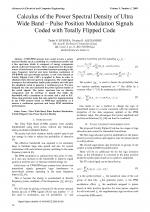| 1/2009 - 3 |
Calculus of the Power Spectral Density of Ultra Wide Band Pulse Position Modulation Signals Coded with Totally Flipped CodeDURNEA, T. N., ALEXANDRU, N. D. |
| Extra paper information in |
| Click to see author's profile in |
| Download PDF |
Author keywords
Ultra Wide Band, Pulse Position Modulation, Totally Flipped Code, Power Spectral Density
References keywords
systems(5), spectral(5), alexandru(4)
Blue keywords are present in both the references section and the paper title.
About this article
Date of Publication: 2009-02-03
Volume 9, Issue 1, Year 2009, On page(s): 16 - 21
ISSN: 1582-7445, e-ISSN: 1844-7600
Digital Object Identifier: 10.4316/AECE.2009.01003
Web of Science Accession Number: 000264815300003
SCOPUS ID: 67749111405
Abstract
UWB-PPM systems were noted to have a power spectral density (p.s.d.) consisting of a continuous portion and a line spectrum, which is composed of energy components placed at discrete frequencies. These components are the major source of interference to narrowband systems operating in the same frequency interval and deny harmless coexistence of UWB-PPM and narrowband systems. A new code denoted as Totally Flipped Code (TFC) is applied to them in order to eliminate these discrete spectral components. The coded signal transports the information inside pulse position and will have the amplitude coded to generate a continuous p.s.d. We have designed the code and calculated the power spectral density of the coded signals. The power spectrum has no discrete components and its envelope is largely flat inside the bandwidth with a maximum at its center and a null at D.C. These characteristics make this code suited for implementation in the UWB systems based on PPM-type modulation as it assures a continuous spectrum and keeps PPM modulation performances. |
| References | | | Cited By «-- Click to see who has cited this paper |
| [1] Proakis, J. G., Salehi, M., "Communication System Engineering", Prentice Hall, Inc. Englewood Cliffs, New Jersey, pp. 493-495, 1994.
[2] Hoffman, J. R. et al., "Measurements to Determine Potential Interference to GPS Receivers from Ultrawideband Transmission Systems", NTIA Report 01-384, pp. 3/1-7/1, 2001. [3] Pointurier, Y. et al., "Power Spectrum of M-Ary PPM", University of Virginia [4] R. J. Fontana, "An insight into UWB interference from a shot noise perspective", IEEE Conference on Ultra Wideband Systems and Technologies, Baltimore, MD, 2002. [CrossRef] [SCOPUS Times Cited 27] [5] Roger A. Dalke et al., "The Temporal and Spectral Characteristics of Ultrawideband Signals", NTIA Report 01-383, pp. 3/1-3/11, Boulder, 2001. [6] FCC Part 15.503, SubPart F "Ultra Wide Band Operation", pp. 767-775, 2002. [7] Krzymien, W. A., "Transmission Performance Analysis of a New Class of Line Codes for Optical Fiber Systems", IEEE Trans. on Communications, vol. 37, pp. 402-404, no. 4, 1989. [CrossRef] [SCOPUS Times Cited 15] [8] Alexandru N. D., Dae Young Kim, "Spectral Shaping via Coding", Cermi, Iasi, pp. 11-27, 2003. [9] Durnea T. N., "An Investigation of Spectral Properties of PPM Signals used in UWB Systems", International Symposium on Signals, Circuits and Systems, Iasi, Romania, 2007. [CrossRef] [SCOPUS Times Cited 2] [10] Alexandru, N. D., Morgenstern, G., "Digital Line Coding and Spectral Shaping", MatrixRom, Bucharest, 1998. [11] Alexandru, N. D., Alexandru, M. L., "Spectral Shaping for Codes with P.S.D. Expressed by Rational Functions", Advances in Electrical and Computer Engineering, vol 8, no. 1, pg. 31-36, 2008. [CrossRef] [Full Text] [SCOPUS Times Cited 3] Web of Science® Citations for all references: 0 SCOPUS® Citations for all references: 47 TCR Web of Science® Average Citations per reference: 0 SCOPUS® Average Citations per reference: 4 ACR TCR = Total Citations for References / ACR = Average Citations per Reference We introduced in 2010 - for the first time in scientific publishing, the term "References Weight", as a quantitative indication of the quality ... Read more Citations for references updated on 2025-05-28 16:10 in 30 seconds. Note1: Web of Science® is a registered trademark of Clarivate Analytics. Note2: SCOPUS® is a registered trademark of Elsevier B.V. Disclaimer: All queries to the respective databases were made by using the DOI record of every reference (where available). Due to technical problems beyond our control, the information is not always accurate. Please use the CrossRef link to visit the respective publisher site. |
Faculty of Electrical Engineering and Computer Science
Stefan cel Mare University of Suceava, Romania
All rights reserved: Advances in Electrical and Computer Engineering is a registered trademark of the Stefan cel Mare University of Suceava. No part of this publication may be reproduced, stored in a retrieval system, photocopied, recorded or archived, without the written permission from the Editor. When authors submit their papers for publication, they agree that the copyright for their article be transferred to the Faculty of Electrical Engineering and Computer Science, Stefan cel Mare University of Suceava, Romania, if and only if the articles are accepted for publication. The copyright covers the exclusive rights to reproduce and distribute the article, including reprints and translations.
Permission for other use: The copyright owner's consent does not extend to copying for general distribution, for promotion, for creating new works, or for resale. Specific written permission must be obtained from the Editor for such copying. Direct linking to files hosted on this website is strictly prohibited.
Disclaimer: Whilst every effort is made by the publishers and editorial board to see that no inaccurate or misleading data, opinions or statements appear in this journal, they wish to make it clear that all information and opinions formulated in the articles, as well as linguistic accuracy, are the sole responsibility of the author.



